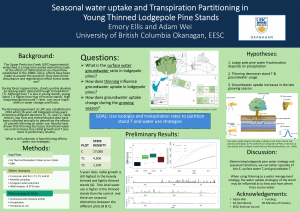
Research poster of proposed research of seasonal distinctions in water source for thinned lodgepole pine stands in British Columbia, CA
This study aims to expand on the current understanding of how thinning young stands changes T at both the tree and stand level and water use strategy. By measuring tree sap fluxes, soil moisture, and stable water isotope analysis of stem water compared to precipitation and groundwater, I hope to determine the ratio of lodgepole pine water sources at UPC and how thinning changes surface water or groundwater dependencies, and how lodgepole pine uptake changes over the growing season. I hypothesize that (1) deeper soil water will be the primary water source for lodgepole pines because of limited summer precipitation events, but that (2) unthinned stands will rely more heavily on precipitation events for water uptake the growing season progresses. Furthermore, (3) I expect that all stands will become increasingly dependent 3
on groundwater over the growing season as surface water and soil moisture decrease, but that the thinned stands will maintain constant groundwater access while the unthinned trees experience restricted water access. Through a detailed partitioning of transpiration sources, we can better understand how lodgepole pines use water, where they access water from, if water uptake changes seasonally, and how thinning affects their water use and uptake strategies.
